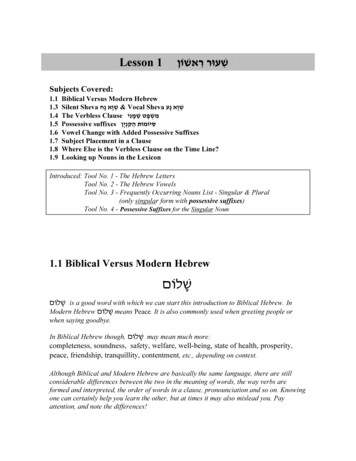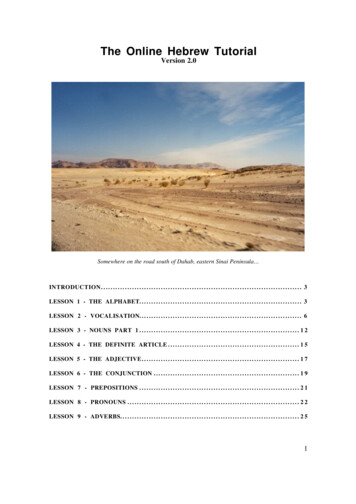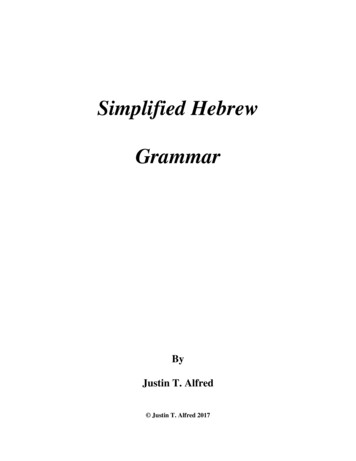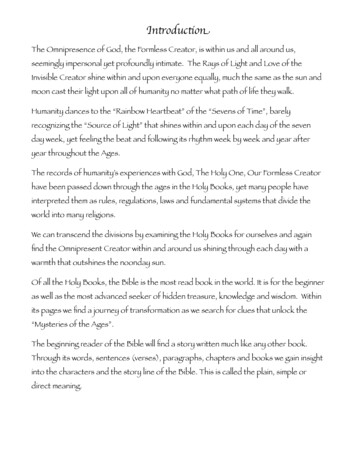
Transcription
Lesson 1 ִ ע ר ִרא Subjects Covered:1.11.31.41.51.61.71.81.9Biblical Versus Modern HebrewSilent Sheva & ְ ָוא ָנח Vocal Sheva ְ ָוא ָנע The Verbless Clause ִמ ְ ָ ט ֵ ָמ ִני Possessive suffixes ִס מ ת ַה ִ ְנָי Vowel Change with Added Possessive SuffixesSubject Placement in a ClauseWhere Else is the Verbless Clause on the Time Line?Looking up Nouns in the LexiconIntroduced: Tool No. 1 - The Hebrew LettersTool No. 2 - The Hebrew VowelsTool No. 3 - Frequently Occurring Nouns List - Singular & Plural(only singular form with possessive suffixes)Tool No. 4 - Possessive Suffixes for the Singular Noun1.1 Biblical Versus Modern Hebrew ָ ל ָ ל is a good word with which we can start this introduction to Biblical Hebrew. InModern Hebrew ָ ל means Peace. It is also commonly used when greeting people orwhen saying goodbye.In Biblical Hebrew though, ָ ל may mean much more:completeness, soundness, safety, welfare, well-being, state of health, prosperity,peace, friendship, tranquillity, contentment, etc., depending on context.Although Biblical and Modern Hebrew are basically the same language, there are stillconsiderable differences between the two in the meaning of words, the way verbs areformed and interpreted, the order of words in a clause, pronounciation and so on. Knowingone can certainly help you learn the other, but at times it may also mislead you. Payattention, and note the differences!
Lesson 1' ִהֵ ה א 1.2 A Warm Up ConversationVocabulary:namenowhat? ֵ לֹא ַמה Let us begin by learning to introduce ourselves to each other.First, read aloud the sentences below as a reading practice.- My name is Shlomo.- My name is Ruth.- Is your name Shemu'el?- No. My name is David.- Is your name Rahel?- My name is Ruth.- What is your name?- My name is Dan.- What is your name?- My name is Dinah.- Is his name Shim'on?- No. His name is Re'uven?- Her name is Rivqah. מה ֹ ֹ ְ ִמי ְ ל . ְ ִמי ר ת ? ִ ְמ ָ ְ מ ֵאל . ְ ִמי ָ ִוד . לֹא ? ְ ֵמ ְ ָרֵחל . ְ ִמי ר ת ? ָ ַמה ִ ְמ . ָ ְ ִמי ? ְ ַמה ְ ֵמ . ְ ִמי ִ יָנה ? ְ מ ִ ְמע . ְ מ ְרא ֵב . לֹא . ְ ָמ ִרְבָקה Notice that in every sentence above, 4 English words were needed to translate 2 Hebrewwords. There are two grammatical reasons that allow Hebrew to express the same idea ina much shorter way: The verbless clause (1.4), and the possessive suffix (1.5). Notice the differences in addressing or talking about a man or a woman. In this lessonyou will also learn about gender distinction (1.5). Use similar sentences to introduce yourself to, and get to know, your classmates. Whiledoing so, use clear gestures to point to yourself and others.
Lesson 1' ִהֵ ה א 1.3 Silent Sheva & ְ ָוא ָנח Vocal Sheva ְ ָוא ָנע Throughout this Lesson you will see words with the vowel sign [ ְ] sheva ְ ָוא ,assigned to one or more letters. This vowel sign represents two different shevas:vocal sheva and silent sheva (see Tool No. 2).Silent sheva has no vowel sound.Silent sheva closes a syllable, e.g. ָצ ְרָעה , ְ ֶח , רבקה , ַאְבָרָה , ָ ִ ְמ It follows the short vowels: [ ַ ] ,[ ִ ] ,[ ֶ ] ,[ ] and the short vowel [ ָ ] (sounds like o inthe English word or [see Tool No. 2]).Vocal sheva should sound like the vowel [ ֶ ] 1. e.g. ִיְרְמָיה , ְרא ֵב , מה ֹ ֹ ְ ל , ְ ִמי 1.4 The Verbless Clause ַה ִ ְ ָ ט ַה ֵ ָמִני In the sentences above (1.2) there are no Hebrew verbs. The verb '( היה to be'), which doesexist in Hebrew, was not used. A clause without a verb, a verbless clause, is common inHebrew. In a verbless clause the predicate (the main information given about the subject)is not a verb. It may be a noun, an adjective, a proper name or others. For example:Moshe is aprophet.Moshe is good.This is Moshe.Moshe is there. מֹ ֶ ה ָנִביא . מֹ ֶ ה ט ב . ֶזה מֹ ֶ ה .! ָ מֹ ֶ ה Note that when translating verbless clauses, the English verb 'to be' should be added.1However, in spoken Hebrew today, the vocal sheva is pronounced this way only with the consonants ר , נ , מ , ל , י , ז , ו . With other consonants that allow slurring, it is reduced to no vowel.
Lesson 1' ִהֵ ה א 1.5 Possessive suffixes ִס מ ת ַה ִ ְנָי Each of the single Hebrew words used in the Warm Up Conversation (1.2): ְ ָמ , ְ מ , ְ ְ ֵמ , ְ ִמי ,ָ ( ִ ְמ her name, his name, your name, my name, your name)has two lexical elements and, therefore, is translated into two English words. Differentsuffixes added to the noun ֵ (name) indicate possession. Each suffix points to the personto whom this ֵ belongs. This is the possessive suffix, which represents a pronoun 2 .Look at the table below demonstrating the possessive suffixes (in bold) assigned to eachgrammatical person, and added to the example noun ( ק ל voice):Translation ofPossessiveSuffixPossessive SuffixTranslation ofPossessiveSuffixPlural Pronounonly ק ֵלנ ק ְלֶכ ק ְלֶכ ouryouryourtheirtheirm. masculine ק ָל ק ָל f. feminineonlymym.yourf.yourm.his, itsf.her, itsPossessive SuffixSingular Pronoun ק ִלי ָ ק ֶל / ָ ק ְל ְ ק ֵל ק ל ק ָל 1st Personm.f.2nd Personm.f.3rd PersonThese possessive suffixes may be added to any singular noun:Possessive SuffixPossessive SuffixPlural Pronounouryouryourtheirtheir ] ֵ [ נ ]ְ [ ֶכ ]ְ [ ֶכ [ָ][ָ]Singular Pronounmym.yourf.yourm.his, itsf.her, its ]ִ [ י ָ [ ֶ ] / ָ [ ְ] ְ [ ֵ ][] [ָ]1st Personm.f.2nd Personm.f.3rd PersonYou will find both of the above tables in Tool No. 4.2 A pronoun stands for someone or something that was mentioned before.Possessive suffixes, like other pronominal suffixes (e.g. those added to verbs, prepositions etc. which willbe introduced in a later stage), represent pronouns; in this case, my, your, his. or me, you, him.
Lesson 1' ִהֵ ה א There is no gender distinction for the 1st person, either singular or plural. Masculine plural ending for both 2nd and 3rd persons ( ֶכ , ָ ) may indicate a mixedgroup of masculine and feminine (e.g. men and women).Note:In this lesson only singular nouns are presented, without or with possessive suffixes;- Plural nouns will be introduced in Lesson 3.- Plural nouns with possessive suffixes will be introduced in Lesson 19.Read aloud the examples below. Use clear gestures to point to yourself or to others toindicate the grammatical person represented by each possessive suffix.their (f.) wellbeingher daughterour voicemy sontheir (m.) motheryour (m. pl.) sisteryour (f. singular) tentyour (f. pl.) covenantyour (m. sing.) home ָ ל ַ ת ק ל ֵ ֵא ָאח ת אֶֹהל ְ ִרית ַ ִית ְ ל ָמ ָ ִ ק ֵלנ ְ ִני ָ ִא ֲאח ְתֶכ ְ ָאֳהֵל ְ ִריְתֶכ ָ ֵ יְת 1234567891.6 Vowel Change with Added Possessive SuffixesAs you can see from the examples above, in some cases, as in ֵ or ֵ , adding thepossessive suffix causes the original vowels of the noun to change. At this level you do notneed to know the vowel change rules. The objective is to learn to recognize a noun with orwithout its added possessive suffix and vowel change. Therefore, gradually, familiarizeyourself with the frequently occurring nouns listed in Tool No. 3.In Tool No. 3, read aloud the following nouns (singular only), without and with theirpossessive suffixes added 3: ְ"ִרית , ַ" ִית , ַ"ת , "ֵ ,! א ֵ , אֶֹהל 3 Plural nouns with possessive suffixes appear on Tool No. 3a , which will be introduced in Lesson 19. For the time being ignore the plural nouns (Lesson 3) printed in bold letters. Also ignore the column presenting the construct state form (Lesson 9).
Lesson 1' ִהֵ ה א ExamplesVocabulary:also, too ַRead aloud the following Biblical passages. Concentrate on the words printed in the largerfonts. Identify the person indicated by each possessive suffix. Compare with the translationoffered.what is thy country? (Jonah 1:8)What is your name (Genesis 32:28). my name is The LORD (Jeremiah 17:21)Neither their silver nor their goldshall be able to deliver them(Zephaniah 1:18)Your country is desolate (Isaiah 1:7)The LORD is our judge,the LORD is our lawgiver,the LORD is our king (Isaiah 33:22)if they return unto Theetheir heartand with all their soul (IKings 8:48)with allYour mother is a Hittite (Ezekiel 16:45)The people on the boat to Yonah:1The man who wrestled with Ya'aqov, to Ya'aqov:2The LORD:3about the people of Yerushalayim:4The LORD to the people of Judah:5( ח , )יונה א ָ ָמה ַאְרְצ .( כח , )בראשית לב ( כא , )ירמיהו טז ָ ֶמ %ְ ַמה ' ְ ִמי ה . ַ'! ַ*ְס ָ( ַ'! ְזָהָב ( יח , לֹא י ַכל ְלַה ִ יָל )צפניה א ַאְרְצֶכ ְ ָמָמה ה' ְֹפֵטנ ה' ְמחֹ ְקֵקנ ( כב , )ישעיהו לג . מְל ֵ*נ ַ ' ה ( ז , )ישעיהו א 6Shelomo, to the Lord about those taken captive:7The LORD to Yerushalayim and its 'sister' cities:8 ָ ְו ָ ב ֵאֶלי ְ ָכל ְלָבָב ( מח , )מלכי א' ח ָ ְבָכל ַנְפ ( מה , )יחזקאל טז ית ,ִ ֶכ ִח -ְ ִא
Lesson 1' ִהֵ ה א One More Conversation (Optional)Vocabulary:goodthanks, thanksgiving ט ב ָדה Now, you are able to ask your classmates questions such as:How are you? (literally: What/how is your )? ָ ל ? ָ ל ְמ %ְ ַמה and receive answers such as:I am well. (literally: My ָ ל is good.). ְ ל ִמי ט ב Try exchanging the following with your classmates:. ָדה . ְ ל ִמי ט ב ? ָ ַמה ְ&ל ְמ . ָ(ִוד , ָ ל . ְ ל ִמי ט ב ? ֶאְס ֵ ר , ְ ַמה ְ&ל ֵמ . ָדה , ְ ל ֵמנ ט ב ? ַמה ְ&ל ְמֶכ , ִ ְמע , מֹ ֶ ה . ָדה , ט ב ? ַמה ְ&ל ְמֶכ , ֵב ְרא , ָ ָמר . ָדה , ְ ל ֵמנ ט ב ? ַמה ְ&ל ְמֶכ , ָיֵעל , ָרה ,ָ
Lesson 1' ִהֵ ה א 1.7 The Subject Place in a ClauseUnlike in English (or in Modern Hebrew) a subject may appear not only at the beginning ofa clause but also later on. For example:Her name is HagarHer name is Sarah. (Sarah is her name). ָהָגר / ְ ָמ / ָרה ְ ָמ 0ָ1.8 Where Else is the Verbless Clause on the Time Line?Up to now you have seen verbless clauses translated into English in the present tense,(using the verb 'to be'). However, if the context relates to the past or to the future, averbless clause may be translated into the past or the future. Thus:David was a king.David is a king.David will be a king.}1ְ ָ ִוד ֶמֶל ExamplesVocabulary:because, when, if, but, ratherNow Sarai Abram's wife bore him no childrenand she had a handmaid, an Egyptian,and hername was Hagar (Genesis 16:1)As for Sarai thy wife,thou shalt not call her name Sarai,but Sarah shall her name be (Genesis 17:15) ִ י ְו ָ ַרי ֵא ֶ ת ַאְבָר לֹא ָיְלָדה ל ְוָל ִ ְפָחה ִמְצִרית ( א , )בראשית טז ָהָגר / ְ ָמ ָ!ְ ְ ָ ַרי ִא לֹא ִת ְקָרא ֶאת ְ ָמ ָ ָרי ( טו , )בראשית יז / ָרה ְ ָמ 0ָ ִ*י 12
Lesson 1' ִהֵ ה א 1.9 Looking up Nouns in the LexiconMost noun entries in the Lexicon include the abreviation sf.( suffix), followed by examplesof the noun with its possessive suffix. Look at the following excerpt from:Holladay, W.L., (1988). A Concise Hebrew and Aramaic Lexicon of the Old Testament. Pages 14-15.Find the nouns: ִא ָ*ר , אְכָלה ָ , אֶֹכל , ֲאִכיָלה , ת 4 ַאְכָזִר
Lesson 1' ִהֵ ה א Exercises1. In your Tool No. 3, read aloud the following nouns (for now, singular only), withoutand with their possessive suffixes added:! ֵ , ִעיר , ַע ִי , ֶעֶבד , ֶנֶפ ,1ְ ֶמֶל , ֵלב , *ֵֹה , ָיד , ָ ָבר ,5 ֶאֶר , ִאי , ָאד 2. Parse and identify the different components of each word listed below.Find them among the frequently occurring nouns in Tool No. 3. Translate.English TranslationSingularTool No. 3 Entry(without suffix)vowels not requiredmy house, home ית Person inSuffix1 s. or p.PossessiveSuffix2 m. or f.s. or p.3 m. or f.s. or p.1s ִ י ֵ יִתי 1 ָיִדי 3 ַע 2 ַחְר ִ י ָ ָיֶד 4 ִא ָיָד 7 ַאְרְצֶכ ָאֳהֵלנ 5689 ַלְחמ 10 ָ ָמ ֵחיָל 12 ֶחְטָא ְ!ב ְדֶכ ְ ק ֵל 11131415
Lesson 1 ִהֵ ה א' 16 ַנַעְרָ 18 ַמְל ֵ!נ 17 19 20 21 22 23 24 1 2 3 4 5 6 7 8 9 ְמק ֵמנ ֹ!ח ַעְבִ י ִ!ְסא ר ִחי ִעיָר ִמְז ַ ֶחָ ִ ְגְ ָ ִ ְנֶכ ִאי ֵ(ְ ְ ָ)ִרי ֵעי ְנֶכ ְ(מ ִאי ָ( ַלְחְמֶכ ֲאד ְנֶכ 10 ַאְרצ 12 ֹרא( ַאְרְצָ 11 13 14 ק ְלֶכ ַר ְגל Your garment 3. Translate the words below (Use Tool No. 3). 15 ִל ַזְרֲעָ ָאִחי ֲע ְנֶכ צאָנ ֹ ְ נ ַר ְגֶלָ 23 ֹרא ִ(י ַנְפ ְ(ֶכ 16 17 18 19 20 21 22 24 25 ְ ִני ַ ְר! 26 ָאִבי 28 ַחְסֵ ְ 27 ְ ָבִרי
Lesson 1' ִהֵ ה א 4. Translate the words listed below using the parsing chart to identify the differentcomponents of each word. Find the nouns in your Lexicon.English TranslationSingularLexicon Entry(without suffix)Person inSuffix1 s. or p.PossessiveSuffix2 m. or f.s. or p.your only onevowels not required יחיד 3 m. or f.s. or p.1ָ ְיִחיְד 1ְ ב ֵנ 6ְ ִע ֲאת נ ! ָ ְרכ מאל ֹ 0ְ/ ָ*ַ י ,ִ מ ַלְד ! ְיִמי ְנֶכ ר ְ"ָקֵרנ 10about the LORD:1The man who wrestled with Ya'aqov, to Ya'aqov:2David mourning the death of .32ms1ָ1234567895. Translate or complete the translation of the following Biblical passages.Consider the context when determining the tense in your translation.(Exodus 15:3)( ג , )שמות טו (Genesis 35:10)( י , )בראשית לה (IISamuel 19:5)( ה , יט , )שמואל ב And there went out a champion from the camp of the Philistines,(ISamuel 17:4) ה' ְ מ קב ֹ ִ ְמָ ַיֲע ְב ִני , ְ" ִני ,! ְ" ִני ַאְב ָ ל ִל ְ ִ!י #ְ ַוֵ'ֵצא ִאי ַה ֵ ַנ ִי ִמ ַ&ֲחנ ת ( ד , )שמואל א' יז ָ'ְלָית ְ מ 4
Lesson 1' ִהֵ ה א 6. Look up the nouns in both your Tool No. 3 and the Lexicon.Complete the translation of the following passages.Note: The word order in Hebrew and English may differ.The LORD to Moshe:. for I have delivered him, and alland hisinto thy,his ,(Deuteronomy 3:2)after thee (Genesis 17:9)And as for thee, thou shalt keepthou, andAnd he struck down everyin(Psalms 105:36)We will go with our young and with our old,with our sons and with our daughters,withand withwe will gofor we must hold a feast unto the LORD (Exodus10:9)LORD, is foreverLORD,
In Biblical Hebrew though, לָ may mean much more: completeness, soundness, safety, welfare, well-being, state of health, prosperity, peace, friendship, tranquillity, contentment, etc., depending on context. Although Biblical and Modern Hebrew are basically the same language, there are still considerable differences between the two in the meaning of words, the way verbs are formed and .










